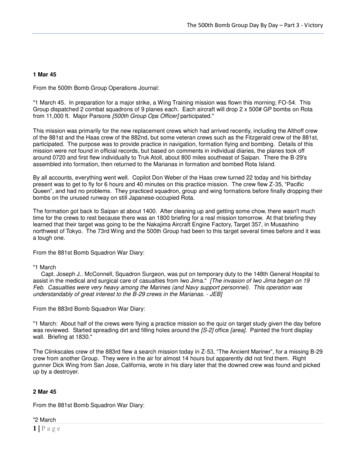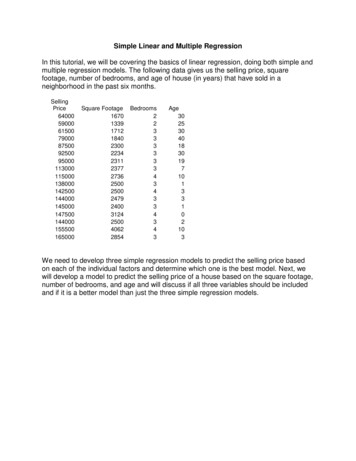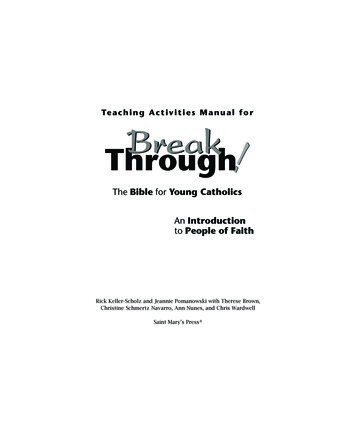
Transcription
What Every Latter-day Saint Should Know about IslamBrian M. Hauglid and Kent P. JacksonBrian M. Hauglid is an assistant professor of ancient scripture at BYU. Kent P. Jackson is aprofessor of ancient scripture at BYU.Islam began in Arabia in the seventh century a.d. and since then has spread to all parts of theearth to become a worldwide faith with about 1.2 billion followers. Given its importance notonly to its many adherents but also to the rest of the world, it is surprising how little Westernersknow about it and how many misconceptions concerning Islam thrive in our culture. Latter-daySaints—who are under a scriptural injunction to learn about “things which are at home, thingswhich are abroad; the wars and the perplexities of the nations, . . . and a knowledge also ofcountries and of kingdoms” (Doctrine and Covenants 88:79)—would be wise to become betterinformed about this influential and rapidly growing religion. i1The name Islam means “submission” (submission to God), and each believer is called a“Muslim” (one who submits to God). Muslims worship the same God (Arabic Allah) thatChristians and Jews worship, “the God of Abraham, and Isaac, and Jacob” (Mosiah 7:19), “theCompassionate, the Merciful” (Qur’an 1:1). Muslims are not a nationality or an ethnic group buta community of believers. They can be found among all races and in every nation, not only in theMiddle East. Although Arabia is the birthplace of Islam, being an Arab is not the same as being aMuslim. An Arab is someone whose native or ancestral language is Arabic, and millions ofArabs in the Middle East are Christians. Indonesia, the most populous Muslim nation in theworld, is three thousand miles from the nearest Arab country and three thousand miles from theMiddle East. Only 20 percent of Muslims worldwide are Arabs, and of the nine nations in theworld with the largest Muslim populations, only one is an Arab country and only three are in theMiddle East. ii2 There are roughly as many Muslims in the United States as Jews or Latter-daySaints.HistoryMuslims view the life of their prophet Muhammad and the origins of Islam as a sacred history.For Muslims this means that God’s hand is evident in the life of Muhammad and what occurredin the centuries after his death. Muhammad’s birth was anticipated, and his entire life is viewedas the model life for every Muslim. Therefore, his life story and the early history of Islam givemeaning to and inform every aspect of the life of Muslims. Even the name Muhammad (“OneWho Is Praised”) is the most common name given to male Muslims. But Muhammad is not a godor divine person who intercedes on behalf of the followers of Islam to provide salvation. He isnot a savior figure. In the Islamic view, Islam began with Adam and was restored by subsequentprophets, the last of whom was Muhammad. He is considered the last in a long successionextending back to Jesus in the New Testament and farther back into the Old Testament to includeprophets such as Adam, Enoch, Noah, Abraham, Solomon, David, and a few not mentioned inthe Bible (for example, Hud and Salih).
Mosaic of Muhammad’s name from the 14th-century tomb of Rumi in Konya, Turkey.Muhammad was born about a.d. 570 to the clan of the Banu Hashim of the Quraysh tribe inMecca, a bustling city of commerce in the Arabian Peninsula. His father died before his birth,and he lost his mother at about age two. After his guardian grandfather also passed away,Muhammad was placed in the care of his uncle, Abu Talib, who raised him to adulthood. At agetwenty-five, Muhammad married Khadija, a merchant woman fifteen years his elder. Khadijaand Muhammad had a happy marriage that produced several children.According to Islamic tradition, Mecca at the time of Muhammad exhibited all the ills of acorrupted and apostate city. Its religious focal point was the Ka‘ba, a large, black, cube-shapedstructure that still stands in Mecca today. In Muhammad’s time, the sacred Ka‘ba complex,which Adam reportedly constructed and Abraham and Ishmael later rebuilt, housed more than365 idol gods. Tribal and clan warfare dominated the area, and the practice of female infanticideprevailed, wherein newborn daughters, who were looked upon as a drain on family productionand finances, were left to die in the desert. Muhammad was very critical of the Meccans. He wasparticularly sensitive to the idolatry and corrupted business practices of the Quraysh merchantstoward the poor, the widows, and his fellow orphans. Muhammad was also quite contemplativeand inclined to a more spiritual outlook on life. Periodically, he would retreat to a cave on MountHira, near Mecca, to practice religious devotions and contemplate “his life and the ills of hissociety, seeking greater meaning and insight.”iii3Muslim tradition records that during one of those retreats, the angel Gabriel appeared toMuhammad and commanded him to recite to his people: “Recite: In the Name of thy Lord whocreated, created Man of a blood-clot. Recite: And thy Lord is the Most Generous, who taught bythe Pen, taught Man that he knew not” (Qur’an 96:1–5).iv4 Muhammad received 114 revelationsover a twenty-three-year period. Within twenty years of his death, Muslims collected therevelations and bound them together to become their sacred book of scripture, the Qur’an (“theRecitation”). The Qur’an is about the same length as the New Testament.Muhammad and his followers experienced many trials and persecutions, particularly from theMeccans of the Quraysh tribe. One of the most difficult personal trials for Muhammad occurredwhen his beloved Khadija and protector uncle Abu Talib died within the same year. It was aboutthat time that Muhammad is said to have been transported on a winged creature to Jerusalem,from which he ascended through several heavens and conversed with many Old Testamentprophets. Muhammad even talked with God.v5 Despite this Year of Sadness (as it later came tobe called), Muhammad’s Night Journey experience strengthened him both physically and
spiritually so he was able to take charge of the fledgling religion and provide the neededleadership for the rest of his life.In a.d. 622, not long after Muhammad’s Night Journey and ascension, God commanded him toleave Mecca and move to Yathrib, a city about two hundred miles north. Because of thesignificance of this move, Yathrib took on the name “the City of the Prophet” (madinat al-Nabi,or Medina). In Medina, Muhammad was able to set up the first Islamic state (umma), whereMuslims acknowledged him as their prophet and political leader. The move from Mecca toMedina, called the hijra, was so important to Muslims that they began to calculate time from thatyear (a.d. 622). Hence, some Muslim calendars contain both hijra and Gregorian dates. Afterseveral battles and skirmishes with opposing Meccan tribes, in a.d. 630 the majority of Meccansaccepted Muhammad and proclaimed him a prophet and the political leader of Mecca andMedina. Upon returning to Mecca, Muhammad cleansed the Ka‘ba of the idol gods and declaredAllah the one and only God.Muhammad did not choose a successor before he died in the arms of his wife Aisha in 632. It issignificant to Muslims that the leaders who followed Muhammad cannot be considered prophetsbecause, according to the Qur’an (33:40), Muhammad was the final prophet. Instead, those earlyleaders were considered representatives or deputies of Muhammad, called caliphs. Today twomajor branches of Islam exist—Sunnis and Shi‘is (or Shi‘ites). Following the death ofMuhammad, the question of who should succeed in the leadership of the community becamecritical. The main question involved whether the community should choose the leader or if adirect blood relative of Muhammad should lead. During the period after Muhammad’s death, hiscousin and son-in-law, ‘Ali, became an immediate candidate of choice. However, the communityselected others until ‘Ali was chosen as the fourth caliph. By that time, enough Muslims wereoffended at ‘Ali being passed over previously that they began to develop into the “Party of ‘Ali”(shi‘at ‘Ali). After ‘Ali and his son were assassinated, the split was cemented even more. Overthe centuries, Shi‘is (those who were loyal to ‘Ali) became prominent from time to time as theirinfluence grew through rising to high levels of leadership in the Islamic world. Today the maindistinction between Sunnis and Shi‘is is still leadership. In principle, Shi‘is believe in a centralleader who can trace his lineage back to Muhammad. Sunnis, on the other hand, govern througha consensus of community leaders. Apart from the question of leadership, Sunnis and Shi‘isagree on most of the basic beliefs and practices of Islam. Geographically, a large concentrationof Shi‘is can be found in Iran, but Shi‘ism also has a presence in other countries, including Iraq,Lebanon, and Pakistan. Sunnis, however, constitute the largest population of Muslimsthroughout the world (about 85 percent).By the eighth and ninth centuries, Islam had already spread from the Arabian Peninsulawestward to Spain and eastward to India. During the Middle Ages, while the West languished inrelative intellectual darkness, Islamic civilization, first centered in Damascus and then inBaghdad, preserved and produced classical knowledge in philosophy, literature, and the sciences,as well as contributing its own unique advances to those and other disciplines. Today one-fifth ofthe world’s population is Muslim, and Islam is now considered one of the fastest-growingreligions on earth.
Shi’ite mosque, Damascus, Syria, marking the burial place of Sayyida Ruqayya, Muhammad’sgreat-granddaughter.Basic Beliefs and PracticesLike Judaism and Christianity (and other major world faiths), Islam is not a monolithic religion.The Islamic world is made up of diverse races, nations, languages, and cultures. Yet Muslims allover the world are united through a number of foundational beliefs and practices.A major belief Islam instills into every aspect of Muslim life is the oneness (tawhid) of God. Itcannot be overstated that Muslims are strict monotheists. In fact, any Muslim who elevatesanything (people, power, greed, status, materials) to the level of God and somehow supplantsHim is guilty of the most grievous and unforgivable sin in Islam (shirk, the association ofanything with God). This was the problem every prophet before Muhammad, and alsoMuhammad himself, had to deal with. In a sense, Islamic sacred tradition teaches adispensational history. Each prophet, usually assisted by an angel, appears on a scene ofwickedness and idolatrous practices and serves as a restorer, bringing back the true worship ofthe one God. But the prophets before Muhammad were never entirely successful at ridding theirpeople of idolatry. Muslims believe that victory over idolatry and apostasy will eventually occur,as evidenced by the rapid growth of Islam since Muhammad.Muslims also believe that the true inner nature of each human being can recognize the oneness ofGod. However, because of the accumulated layers of pride, greed, or worldly preoccupations,people forget and neglect God. In traditional Christianity, original sin is Adam’s disobedience toGod’s commandment, which is transferred to each person. In Islam, original sin is forgetfulnessand neglect. To overcome the consequences of sin, a Christian needs the grace of Christ’sAtonement; in Islam, a Muslim needs to remember the oneness of God. To help Muslimsremember God, it is common to see the use of a string of prayer beads, containing ninety-nine
beads, each corresponding to one of the ninety-nine names of God. Many Muslims will recitethose names on a daily basis. In Islam, recognizing and remembering the oneness of God is ofparamount importance.Islam teaches all Muslims to know and do the will of God. Muslims who want to teach this basicconcept to Christians and know something of the Bible commonly refer to Jesus’ teaching inMatthew 6:10, “Thy will be done in earth, as it is in heaven.” In the Book of Mormon, Jacob alsoteaches the principle of following the will of God: “Wherefore, my beloved brethren, reconcileyourselves to the will of God, and not to the will of the devil and the flesh” (2 Nephi 10:24). Forevery Muslim, God’s will is made manifest in the Qur’an and in the sayings and acts ofMuhammad (sunna). Muslims view the Arabic Qur’an much the same way that Christians viewJesus Christ. According to one prominent Muslim scholar, “In Christianity both the spirit andbody of Christ are sacred, and he is considered the Word of God. The Qur’an is likewise forMuslims the Word of God (kalimat Allah), and both its inner meaning, or spirit, and its body, orouter form, the text in the Arabic language in which it was revealed, are sacred to Muslims.” vi6Muslims consider Muhammad’s teachings and example second only to the teachings of theQur’an, and therefore great strides were made in the early centuries of Islam to collect anddocument every known report (hadith) of Muhammad’s words and deeds. Every field of Islamicinquiry—such as theology, philosophy, law, and mysticism—finds its bearings first in theQur’an and then in the teachings of Muhammad. Although some Muslims have interpreted theQur’an and Muhammad’s teachings as justification for extremism, the majority of Muslims takea much more moderate approach.While it is true that Muslims believe in the oneness of God, in doing His will, and in themanifestation of these in the Qur’an and in Muhammad’s teachings, Islam is still very muchfocused on what Muslims must do with their faith to remember God and do His will. Therefore,drawing from the Qur’an and Muhammad’s life, Muslims unanimously accept five mandatorypractices: the witness of faith (the shahada), prayer, fasting, almsgiving, and pilgrimage. Theseare commonly referred to as the Five Pillars of Islam.Shahada. In the witness of faith, one declares the oneness of God and Muhammad’sprophethood. One must verbally declare the witness of
corrupted and apostate city. Its religious focal point was the Ka‘ba, a large, black, cube-shaped structure that still stands in Mecca today. In Muhammad’s time, the sacred Ka‘ba complex, which Adam reportedly constructed and Abraham and Ishmael later rebuilt, housed more than 365 idol gods. Tribal and clan warfare dominated the area, and .











